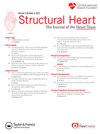Conduction Disorders After Transcatheter Aortic Valve Implantation: Evolution Over Time and Association With Long-Term Outcomes
IF 1.4
Q3 CARDIAC & CARDIOVASCULAR SYSTEMS
引用次数: 0
Abstract
Background
Expanding indications for transcatheter aortic valve implantation (TAVI) highlighted the importance of complications such as new left bundle branch block (LBBB) or permanent pacemaker (PPM) implantation. However, studies on the long-term outcomes of these conduction abnormalities (CA) are limited. This study aims to examine the progression of CA within the first year after TAVI and their long-term prognostic value.
Methods
TAVI patients were divided into 1) PPM implantation within the first year, 2) post-TAVI LBBB persisting until 1 year (permanent LBBB), and 3) no-CA. Endpoint was all-cause mortality after 1 year.
Results
Among 794 patients initially included, 30% developed new LBBB, which persisted in 17% until discharge; 12% received a PPM during the hospitalization. One-year follow-up was available in 502 patients: 11% were classified as permanent LBBB (n = 56), 18% as PPM (n = 89), and the rest as no-CA (n = 357). Baseline characteristics were comparable, except for valve type, with self-expanding more common among the PPM group. At 1-year follow-up, lower left ventricular ejection fraction and global longitudinal strain were observed in the PPM and permanent LBBB groups compared to the no-CA group (55% ± 9% and 15% ± 4% vs. 54% ± 11% and 15% ± 4% vs. 58% ± 9% and 17% ± 4%, respectively, p < 0.001). At long-term follow-up (median: 4 [interquartile range: 3-6] years), higher mortality was observed in the PPM group (ꭓ2 = 10.168, p = 0.006). In addition, PPM implantation (hazard ratio: 1.654, p = 0.011) and global longitudinal strain at 1 year (hazard ratio: 0.950, p = 0.027), as well as pre-TAVI EuroSCORE II and New York Heart Association III-IV at 1 year, were independently associated with the outcome.
Conclusions
Post-TAVI CAs are dynamic within the first year. Patients who needed PPM implantation did not show significant improvement in left ventricular function after TAVI and had higher long-term mortality.
经导管主动脉瓣植入术后的传导障碍:随时间的演变及其与长期预后的关系
背景:经导管主动脉瓣植入术(TAVI)的适应症扩大,强调了并发症的重要性,如新的左束支阻滞(LBBB)或永久起搏器(PPM)植入术。然而,对这些传导异常(CA)的长期结果的研究是有限的。本研究旨在探讨TAVI术后一年内CA的进展及其长期预后价值。方法将stavi患者分为三组:1)1年内植入PPM, 2) tavi后LBBB持续至1年(永久性LBBB), 3)无ca。终点是1年后的全因死亡率。结果纳入的794例患者中,30%出现新的LBBB, 17%持续至出院;12%的患者在住院期间接受了PPM。502例患者随访1年,其中11%为永久性LBBB (n = 56), 18%为PPM (n = 89),其余为无ca (n = 357)。基线特征具有可比性,除了阀门类型,自膨胀在PPM组中更常见。在1年的随访中,与无ca组相比,PPM组和永久性LBBB组的左心室射血分数和整体纵向应变较低(分别为55%±9%和15%±4% vs. 54%±11%和15%±4% vs. 58%±9%和17%±4%),p <;0.001)。在长期随访中(中位数:4[四分位数间距:3-6]年),PPM组的死亡率较高(ꭓ2 = 10.168,p = 0.006)。此外,PPM植入(风险比:1.654,p = 0.011)和1年时的整体纵向应变(风险比:0.950,p = 0.027)以及tavi前的EuroSCORE II和1年时的New York Heart Association III-IV与结果独立相关。结论tavi术后一年内ca是动态的。需要PPM植入的患者在TAVI后左心室功能没有明显改善,长期死亡率更高。
本文章由计算机程序翻译,如有差异,请以英文原文为准。
求助全文
约1分钟内获得全文
求助全文
来源期刊

Structural Heart
Medicine-Cardiology and Cardiovascular Medicine
CiteScore
1.60
自引率
0.00%
发文量
81
 求助内容:
求助内容: 应助结果提醒方式:
应助结果提醒方式:


